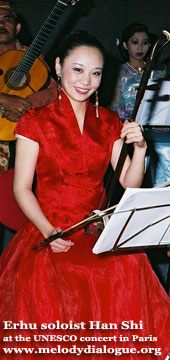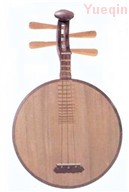让我们最后一次的看看陪我们走过了不知多少年的华乐室,
一路走来,真的不容易。。。
那儿聚集了——热爱中华的。。。
热爱华乐的。。。。
我们。。。
就因为爱它。。。
一间不算宽敞的华乐室!
让我们彼此认识。。。相聚一起。。。









Erhu - Chinese violin or fiddle
Chinese two-stringed bowed instrument

 Erhu is a kind of violin (fiddle) with two strings which, together with zhonghu, gaohu, sihu, etc, belongs to the "huqin" family. It is said that its origin would be dated up to the Tang dynasty (618-907) and related to the instrument, called xiqin originated from a Mongolian tribe Xi. During Song dynasty (960-1279), the instrument was introduced to China and was called "Ji Qin". Soon the second generation of the huqin was among the instruments played at the imperial banquets. During the Dynasties of Yuan (1206-1368), Ming (1368-1644) and Qing (1644-1911), the erhu underwent a great development at the time of the golden age of the local operas. The erhu then developed in a different "schools". Two famous artists Hua Yanjun (1893-1950) and Liu Tianhua (1895-1932) made an exceptional contribution to the improvement of the erhu, and it was indeed due to the latter that the erhu, an instrument mainly for accompaniment in an opera, becomes a solo instrument. After the foundation of People's Republic of China (1949), the manufacture of the erhu, the playing techniques, the repertoire as well as the musical education of this instrument have undergone an unpresidented development. The repertoire has grown rapidly in the genres of solo, with ensemble as well as concerti with symphony orchestra. Erhu now has become one of the most popular instruments in China.
Erhu is a kind of violin (fiddle) with two strings which, together with zhonghu, gaohu, sihu, etc, belongs to the "huqin" family. It is said that its origin would be dated up to the Tang dynasty (618-907) and related to the instrument, called xiqin originated from a Mongolian tribe Xi. During Song dynasty (960-1279), the instrument was introduced to China and was called "Ji Qin". Soon the second generation of the huqin was among the instruments played at the imperial banquets. During the Dynasties of Yuan (1206-1368), Ming (1368-1644) and Qing (1644-1911), the erhu underwent a great development at the time of the golden age of the local operas. The erhu then developed in a different "schools". Two famous artists Hua Yanjun (1893-1950) and Liu Tianhua (1895-1932) made an exceptional contribution to the improvement of the erhu, and it was indeed due to the latter that the erhu, an instrument mainly for accompaniment in an opera, becomes a solo instrument. After the foundation of People's Republic of China (1949), the manufacture of the erhu, the playing techniques, the repertoire as well as the musical education of this instrument have undergone an unpresidented development. The repertoire has grown rapidly in the genres of solo, with ensemble as well as concerti with symphony orchestra. Erhu now has become one of the most popular instruments in China. The sound body of the erhu is a drum-like little case usually made of ebony or sandalwood and snake skins. It usually has a hexagonal shape with the length of approximately 13 cm. The front opening is covered with skin of python (snake) and that of the back is left open. The functions of this case of resonance are to amplify the vibrations of the strings. The neck of the erhu is about 81 cm long and is manufactured with the same materials as the drum. The top of the stem is bent for decoration. The two strings of the erhu is usually tuned D and A. The two tuning handles (pegs) are found close to the end of the stem. There is no frets (as contrast to the lute) or touching board (as contrast to violin). The player creates different pitches by touching the strings at various positions along the neck of the instrument. The strings are usually made of silk or nylon. Nowadays, metal strings are commonly used. The bow is 76 cm long and is manufactured of reed which one curves during cooking, and arched with horse hair in the same way as the bow of violin. However, in the case of erhu, the horse hair runs between the two strings. In another word, one cannot take off the bow from the instrument unless one of the two strings is taken off or broken.
The posture which the player must adopt to play the erhu is the same as that adopted for the other kinds of huqin: the left hand holding the fiddle and the right hand, the bow. The erhu is put on the lap vertically, the left hand moves vertically to touch the strings for the right pitch while the left hand (with the bow) move horizontally to make the sound. The Erhu is mainly a instrument for melody in a sense like voice. The left hand slides up and down the instrument while fingers pressing the strings to create desired pitch and "sliding" effects. The right hand pushes the horse hair against this or that string while moving horizontally, to create the sounds on either of the two strings. Occasionally some musicians hold the instrument with the help of a rope, in the same way as for saxophone, in order to play standing or walking. However it doesn't look elegant with the sound body pressing against the belly of the performer and the stem of the instrument pointing up and outwards. Therefore, the musicians normally play sitted unless it's absolutely necessary. In the old days, street musicians often used this method in order to play while walking. Today, in some pop or rock bands, musicians use this method of playing in order to act on the stage.
The erhu sounds similar to human voice, and can imitate many natural sounds such as birds and horse. It is a very expressive instrument, most well-known for playing melancholic tune, but also capable of play merry melody.
The erhu often plays an important role in the national orchestras. In the smaller orchestras, there are usually 2 to 6 erhu, in larger ones, 10 with 12. In fact, the erhu plays the same role as the violin in the Western orchestras.
Guzheng - Chinese Zither
One of the most ancient Chinese traditional music instruments

|
The Chinese character for "zheng" composed of two parts: the upper part means "bamboo" and the lower part is "argue" (see the above character). According to a legend, there was a master of se, 25-stringed zither, who had two talented daughters who love playing the instrument. Now there came a time that the master became too old, and wanted to pass his instrument over to one of them. However, both daughters wanted to have it. The master felt miserable and finally, out of desperate, he decided to split the instrument into two - one got 12 strings, and the other 13. To his amazement, the new instrument sounds mellow and even more beautiful than its original. The happy master gave the new instrument a new name "zheng" by making up the character with the symbolisms representing "bamboo" and "argue". The word "zheng", the name of this instrument, pronounces the same as the word "zheng" which means "argue" or "dispute". The origin of the Chinese character representing this instrument seems to indicate that the early version of the instrument was made of bamboo, which is different from that of today. However, this legendary story, though it might be true according to the origin of the Chinese character for this instrument, should not be taken too seriously. Zheng (Guzheng) is build with a special wooden sound body with strings arched across movable bridges along the length of the instrument for the purpose of tuning. In the early times the zheng had 5 string; later on developed into 12 to 13 strings in the Tang Dynasty (618 - 907AD) and 16 strings in the Song and Ming dynasty (from the 10th to 15th century). The present day zheng usually has 21-25 strings.
techniques: Guzheng player attaches a little plectrum on each finger using a special tape. For traditional repertoires, the instrumentalist mostly uses three fingers of the right hand for plucking whereas the left hand pressing the string from the other side of the bridge to create special tonalities and ornaments. For some contemporary repertoires, both hands are needed to produce complicated harmonies using four fingers of each, which means that even the fingers of the left hand need to ware plectrums. In some cases, one can use cello bow to play on the Guzheng to produce sustained sounds and special effects. One can also use sticks to hit on the strings in the way like a percussion instrument. |
Ruan ( )- very ancient four-stringed moon-shaped lute with long and straight neck and various number of frets, dated back at least to Qin Daynasty (around 200 BC). Ruan is used to
)- very ancient four-stringed moon-shaped lute with long and straight neck and various number of frets, dated back at least to Qin Daynasty (around 200 BC). Ruan is used to  be called "p'i-p'a" (pipa) or qin-pipa. Since the introduction of the oud-like lute through the "silk-road" in the early Tang Dynasty (around 5th century), the pipa gradually developed into the present form, and the old form of pipa with straight-neck and round body got the name "Ruan", after the name of the master player of this instrument, Ruan Xian who was one of the seven great scholars known as "The Seven Gentlemen in the Bamboo Forest" in Chinese history of the 3rd century (the Six Dynasties). They were truely good friends.
be called "p'i-p'a" (pipa) or qin-pipa. Since the introduction of the oud-like lute through the "silk-road" in the early Tang Dynasty (around 5th century), the pipa gradually developed into the present form, and the old form of pipa with straight-neck and round body got the name "Ruan", after the name of the master player of this instrument, Ruan Xian who was one of the seven great scholars known as "The Seven Gentlemen in the Bamboo Forest" in Chinese history of the 3rd century (the Six Dynasties). They were truely good friends.  Ruan Xian and Ji Kang, master of guqin (Chinese 7-stringed zither), are most famous for their musical achievements and the life as true artists. The Ruan is mostly used for Peking opera, and now also in modern Chinese orchestra. There are family of ruan of various size including "Zhong Ruan" (middle Ruan) and "Da Ruan" (large Ruan) used in the same sense as viola and cello in western orchestra.
Ruan Xian and Ji Kang, master of guqin (Chinese 7-stringed zither), are most famous for their musical achievements and the life as true artists. The Ruan is mostly used for Peking opera, and now also in modern Chinese orchestra. There are family of ruan of various size including "Zhong Ruan" (middle Ruan) and "Da Ruan" (large Ruan) used in the same sense as viola and cello in western orchestra. ![]()
![]()
 )- moon-shaped lute with shorter neck and four strings, played with a spectrum, used for accompanying local operas. "Yue" stands for "the moon" in Chinese.
)- moon-shaped lute with shorter neck and four strings, played with a spectrum, used for accompanying local operas. "Yue" stands for "the moon" in Chinese.